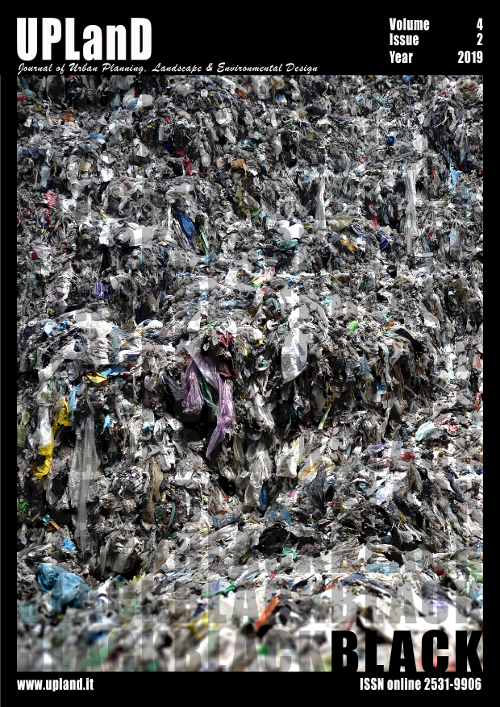Organic waste management through anaerobic digester technologies in urban areas. A multicriterial predesign tool to support urban strategies
Main Article Content
Abstract
The daily production of waste within urban areas represents an opportunity to transform its organic fraction in biogas through anaerobic digestion, but until now it has not been studied and considered as an applicable urban solution. This paper presents a part of the results achieved in the research named “Smart Biogas Grid”, study conducted with the aim to investigate the perspective for the realization of small-scale anaerobic digesters to produce biogas exploiting bio-waste produced in urban areas. While the scientific technical literature on biogas is deeply investigated, experiences and literature for urban context are poor with only few cases and prototypes. Starting with the presentation of a case pilot of anaerobic digester realized in Camley Street Park in London, UK, the paper goes beyond the only technical and technological aspects, considering the role of non-technical features of anaerobic digester installation and providing a transversal analysis to focus on the architectural and urban planning consequences. It emerges the need for a multi and inter-disciplinary approach that can find in the support of early design tool and useful instrument to help in organizing and managing the contents proper of different disciplines; the tool presented in the paper has this purpose. Through a multi-criteria decision analysis, statistical data, features of the urban areas object of intervention, the tool defines a set of solutions, which can contribute in the activation of strategies of waste prevention, energy utilization and community awareness thanks to people/stakeholders engagement at different scales. The result is a decision-making tool useful to direct pathways for socio-technical transition from a district to the city scale, supporting the definition of urban local strategy to the creation of anaerobic digesters in urban areas, in existing as well as in new settlements.
Downloads
Article Details
- Authors retain copyright and grant the journal right of first publication with the work simultaneously licensed under a Creative Commons Attribution License that allows others to share the work with an acknowledgement of the work's authorship and initial publication in this journal.
- Authors are able to enter into separate, additional contractual arrangements for the non-exclusive distribution of the journal's published version of the work (e.g., post it to an institutional repository or publish it in a book), with an acknowledgement of its initial publication in this journal.
- Authors are permitted and encouraged to post their work online (e.g., in institutional repositories or on their website) prior to and during the submission process, as it can lead to productive exchanges, as well as earlier and greater citation of published work (See The Effect of Open Access).
References
http://task37.ieabioenergy.com/files/daten-redaktion/download/publi-task37/digestate_quality_web_new.pdf
Al Seadi, T., Drosg, B., Fuchs, W., Rutz, D., & Janssen, R. (2013). Biogas digestate quality and utilization. In A. Wellinger, J. Murphy, & D. Baxter (Eds.), The Biogas Handbook (pp. 267–301). Sawston, UK: Woodhead Publishing.
Stenmarck, Â., Jensen, C., Quested, T., Moates, G., Buksti, M., Cseh, B., ... & Scherhaufer, S. (2016). Estimates of European food waste levels. Stockholm, SE: IVL Swedish Environmental Research Institute.
Baxter, D., & Al Seadi, T. (2013). AD of the organic fraction of MSW System overview for source and central separated waste. Retrieved from
https://www.ieabioenergy.com/wp-content/uploads/2013/09/AD-of-the-organic-fraction-of-MSW-Baxter.pdf
Energy – UN-Habitat. (n.d.). Retrieved from
https://unhabitat.org/urban-themes/energy/
European Commission. (2017). Waste - Environment. Retrieved from
http://ec.europa.eu/environment/waste/
European Parliament and Council. Directive 2008/98/EC on waste and repealing certain Directives (2008). Retrieved from
http://eur-lex.europa.eu/legal-content/EN/TXT/?uri=celex%3A32008L0098
Eurostat. (2016). Municipal waste statistics - Statistics Explained. Retrieved from
http://ec.europa.eu/eurostat/statistics-explained/index.php/Municipal_waste_statistics
Geels, F. W. (2002). Technological transitions as evolutionary reconfiguration processes: a multi-level perspective and a case-study. Research Policy, 31(8–9), 1257–1274. doi: 10.1016/S0048-7333(02)00062-8
Hao, X., Novotny, V., & Nelson, V. (2010). Water Infrastructure for Sustainable Communities. London, UK: IWA Publishing.
LEAP - Local Energy ADventure Partnership. (n.d.). The Anaerobic Digestion Greenhouse Option. Retrieved from
http://communitybydesign.co.uk/pages/greenhouse-option
Piippo, S., Saavalainen, P., Kaakinen, J., & Pongrácz, E. (2015). Strategic waste management planning – the organization of municipal solid waste collection in Oulu, Finland *. Pollack Periodica, 10(2), 145–156. doi: 10.1556/606.2015.10.2.13
Tomperi, J., Luoma, T., Pongrácz, E., & Leiviskä, K. (2014). Energy potential of biodegradable wastes in Kolari. Pollack Periodica, 9(Supplement 1), 5–15. doi: 10.1556/Pollack.9.2014.S.1
United Nations. (2014). World Urbanization Prospects.
Walker, M., Theaker, H., Yaman, R., Poggio, D., Nimmo, W., Bywater, A., … Pourkashanian, M. (2017). Assessment of micro-scale anaerobic digestion for management of urban organic waste: A case study in London, UK. Waste Management, 61, 258–268. doi: 10.1016/j.wasman.2017.01.036

